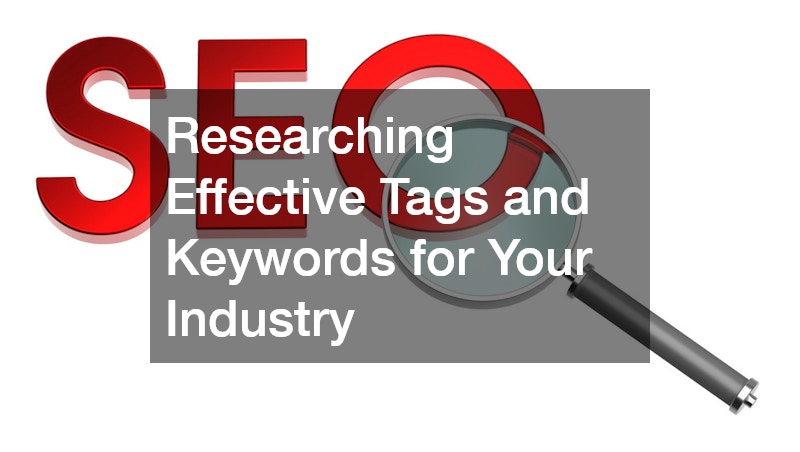
When it comes to search engine optimization (SEO), one of the most crucial aspects of your digital marketing strategy is selecting the right tags and keywords. Tags and keywords are the foundation of your SEO efforts, as they help search engines understand the context and relevance of your content. Using the right combination of keywords and tags can drastically increase your visibility on search engine results pages (SERPs), driving more targeted traffic to your website. In this article, we will explore how to effectively choose tags and keywords for various industries, including those related to estate law, car repair shops, pest management, local movers, and more.
Understanding the Role of Tags and Keywords in SEO
Tags and keywords are terms that you use to describe the content of your webpage. Keywords are specific words or phrases that users type into search engines when looking for information. Tags, on the other hand, are labels or categories you assign to content to help organize it for both users and search engines. Together, they guide search engines in categorizing and ranking your content based on its relevance to specific queries.
For example, a local emergency room might use keywords like “emergency care,” “urgent care,” or “24-hour emergency room” to attract people looking for urgent medical attention. Similarly, a pest management company might use tags and keywords like “pest control,” “termite inspection,” and “extermination services” to ensure their content appears when potential customers search for pest control services.

Researching Effective Tags and Keywords for Your Industry
Choosing the right tags and keywords requires an understanding of both your industry and your target audience. Keywords should reflect the most common search terms related to your business while also considering the competition for those terms. In competitive industries, such as real estate, there may be thousands of businesses vying for top rankings on common keywords. For an estate lawyer, for example, common keywords might include “estate planning lawyer,” “wills and trusts attorney,” or “probate law expert.”
For businesses like car repair shops or tree service providers, the selection of keywords should focus on specific services or locations. “Car repair shops” could target more localized terms like “auto repair near me” or “affordable car repair in [city].” A tree service company, on the other hand, might use keywords like “tree trimming,” “emergency tree removal,” or “affordable arborist services.”
Understanding user intent is also key to selecting effective tags and keywords. Are people searching for information, services, or products? When users search for a “local pediatrician,” for example, they are likely looking for a nearby healthcare provider for their child, which is a high-intent keyword. Keywords for service-based businesses such as “local movers” or ” CPA service” also tend to be high-intent, as they are often searching for immediate services in their area.
Long-Tail Keywords: A More Targeted Approach
While short keywords like “real estate lawyer” or “car detailing” are helpful, they often come with high competition, making it difficult to rank highly in search results. This is where long-tail keywords can be extremely beneficial. Long-tail keywords are longer, more specific phrases that reflect a user’s detailed search intent.
For instance, instead of just targeting “estate lawyer,” you could use long-tail keywords such as “affordable estate lawyer in [city]” or “best estate lawyer for trust administration.” Similarly, for a business offering car detailing services, targeting long-tail keywords like “mobile car detailing near me” or “best car detailing service in [city]” would attract more qualified leads.
Long-tail keywords not only help improve SEO performance but also drive more qualified traffic to your website. When users enter a more specific search term, they are often further along in their decision-making process, making them more likely to convert. For example, someone searching for “tree service in [city]” is likely in need of tree trimming or removal, compared to someone simply searching for “tree service,” which may return a wide range of results.
Using Tags and Keywords for Local SEO
Local SEO is essential for businesses that rely on local clientele, such as car repair shops, pest management services, and local movers. By focusing on local keywords, you can improve your chances of appearing in search results for users in your geographic area. For example, a “local pediatrician” might use keywords such as “pediatric care in [city]” or “children’s doctor near me” to attract parents seeking a trusted healthcare provider for their kids.
Local SEO involves optimizing your website and content for location-based search queries. This can be achieved by incorporating location-specific keywords into your titles, headings, and meta descriptions. Additionally, consider claiming and optimizing your Google My Business listing to help your business show up in Google’s Local Pack, which often features local emergency rooms, movers, tree services, or car detailing providers.
You should also include local landmarks, neighborhoods, or regions in your tags and keywords. For instance, if you’re a local mover, you might include keywords like “moving company in [neighborhood]” or “movers in [city].” This helps search engines recognize your business as relevant to users in that specific location.

The Importance of Keyword Density and Placement
While choosing the right tags and keywords is essential, how you use them in your content also plays a significant role in your SEO efforts. Keyword density refers to how often a keyword appears in your content relative to the total word count. Too few keywords might make your content hard for search engines to identify, while too many can make your content appear spammy and negatively impact your ranking.
A general rule of thumb is to aim for a keyword density of around 1-2% of the total word count. For example, if you’re writing a 1,000-word article, you would aim for your target keyword to appear approximately 10-20 times. However, make sure to use keywords naturally and avoid keyword stuffing, as this can harm the user experience and result in penalties from search engines.
Keyword placement is also important. It’s not just about how many times you use the keyword, but also where you place it. For SEO purposes, try to include your primary keyword in the title, header tags (H1, H2, etc.), URL, and meta description. For instance, a website offering tree services could optimize its page title to read “Expert Tree Service in [City] – Affordable Tree Trimming and Removal.”
Tags and Keywords for Different Types of Services
Different types of businesses require unique keyword strategies based on the services they offer. For example, a CPA service should target keywords like “tax preparation,” “small business accounting,” or “financial planning,” along with long-tail keywords such as “affordable CPA service in [city].”
In the case of a private high school, you might use keywords like “best private high school in [city]” or “college prep school,” targeting parents looking for educational institutions for their children. Similarly, pest management companies can use keywords such as “termite control,” “pest exterminator,” or “bed bug removal,” depending on the specific services they offer.
Understanding your service offerings and aligning them with the appropriate keywords will improve the chances of your business being discovered by the right audience. For example, a car repair shop should focus on terms like “brake repair,” “engine diagnostics,” and “auto mechanic,” while a tree service business would want to use keywords like “tree removal,” “stump grinding,” or “emergency tree service.”
Creating Quality Content Around Tags and Keywords
Once you’ve selected your tags and keywords, the next step is to create high-quality content that incorporates them naturally. Quality content is not just about cramming keywords into your posts but providing valuable and informative material that answers users’ questions or solves their problems.
For example, a blog post by a local pediatrician might focus on “How to Choose the Best Pediatrician for Your Child” and naturally incorporate keywords such as “local pediatrician,” “children’s healthcare provider,” and “best pediatrician in [city].” Similarly, a tree service company might write a blog post on “How to Spot the Signs of a Dangerous Tree” and include keywords like “tree trimming,” “emergency tree removal,” and “tree health.”
The goal is to strike a balance between optimizing your content for search engines and making it engaging and useful for your audience. When users find your content valuable, they are more likely to stay on your site longer, share it with others, and convert into customers.

Tracking the Success of Your Tags and Keywords
After implementing your tags and keywords, it’s important to track the performance of your SEO efforts. Use tools like Google Analytics, SEMrush, or Ahrefs to monitor how your pages are performing in search results. These tools can help you identify which keywords are driving the most traffic, how your pages are ranking, and whether there are any opportunities to improve your strategy.
If certain keywords aren’t performing as expected, you may need to adjust your content or focus on different, less competitive keywords. For example, if your “car repair shops” page isn’t ranking well for highly competitive terms, consider switching to more specific long-tail keywords like “affordable auto repair in [city]” or “emergency car repair.”
Regularly updating your tags and keywords based on performance data will help you stay ahead of the competition and ensure that your SEO strategy remains effective in the long run.
How to Avoid Keyword Cannibalization
One common mistake many businesses make when selecting tags and keywords is keyword cannibalization, a situation where multiple pages on your website target the same keyword or phrase. This can confuse search engines, making it harder for them to determine which page should rank for that particular term. For example, a local movers business might inadvertently create several pages that target the same keyword, such as “moving services in [city]” across various pages about different types of moving (e.g., residential, office, or long-distance moving).
To avoid this, make sure each page of your website has a distinct focus and is optimized for different, relevant keywords. If you’re a pest management service, don’t use the same keyword like “pest control in [city]” across multiple pages. Instead, create unique content for each service you offer, such as “termite control in [city],” “bed bug extermination,” or “ant removal.” Each page should target a specific service or location to improve its chances of ranking.
Additionally, if you find that you’re ranking for the same keyword across multiple pages, consider consolidating or redirecting some pages to avoid cannibalizing your own rankings. The goal is to ensure each page is treated as the best source for a unique search intent.
Using Tags and Keywords for Voice Search Optimization
As the use of voice-activated devices like Siri, Alexa, and Google Assistant continues to rise, optimizing your content for voice search has become increasingly important. Voice search queries often differ from typed searches in terms of phrasing and length. People tend to ask questions in a more conversational manner when using voice search, which means long-tail keywords become even more important for businesses.
For example, a user searching for an estate lawyer may type “What’s the best estate lawyer near me?” in a search engine, but when using voice search, they might ask, “Who is the top estate lawyer in [city]?” or “How can I find a good estate lawyer for my will?” By recognizing these nuances in voice search, businesses can adapt their keyword strategy to be more natural and conversational.
To optimize for voice search, incorporate question-based keywords into your content, such as “How to find the best local pediatrician for your child?” or “What should I look for in car repair shops?” Ensure your content answers these questions directly, as search engines tend to prioritize featured snippets and concise, informative answers that match the natural language people use in voice queries.
By focusing on long-tail, question-based keywords, you not only improve your chances of being featured in voice search results but also increase your visibility for a wider range of user intents, from car detailing services to tree service inquiries.

Conclusion: Refining Your SEO Strategy with the Right Tags and Keywords
In conclusion, choosing the right tags and keywords is essential for optimizing your website and driving traffic to your business. Whether you are a real estate lawyer, car repair shop owner, local pediatrician, or tree service provider, effective SEO strategies start with carefully selecting the right keywords that align with your business and audience’s needs.
By conducting thorough keyword research, focusing on local SEO, using long-tail keywords, and creating high-quality content around your tags and keywords, you can improve your search engine rankings and attract more targeted customers. Tracking the success of your SEO efforts will also help you refine your strategy over time, ensuring that your business stays visible and competitive in the digital landscape.
Remember, SEO is not a one-time effort but an ongoing process. By consistently optimizing your content with the right tags and keywords, you can improve your rankings and ultimately grow your business.



